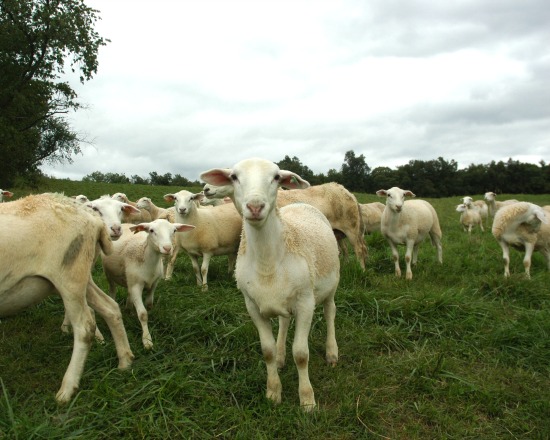For many people, their connection with the farms that produce their food is more of a rather abstract idea—a short blurb on the plastic container that paints a bucolic image of the source of their salad greens. Such a brief cannot create a sense of connection with the land, much less convey the commitment of the farmers or the lives of the animals, making it an easy (and arguably deserving) target of Portlandia satire. But just as food enthusiasts are becoming aware of the intricate relationships between farming practices and the environment, public health and sustainability, farmers are dependent on consumer awareness, interest and purchasing power to support their operations.
Chef Michelle Warner of Down on the Farm NY (and who also teaches classes at The Brooklyn Kitchen) has started bringing farmers and consumers together through farm visits around the New York area. A couple of weeks ago, I had the opportunity to follow her on a visit to Kinderhook Farm and get a glimpse into the workings of one of Hudson Valley’s largest grassfed beef and lamb farms. I went as part of a tour, which also included cooking lessons and a dinner.
The farm began when Steve Clearman and Renee Iacone learned that a 1,200-acre dairy farm up the road from their new home was for sale, and they were inspired by the prospect of preserving the land as a working farm. Needing farmers to work the land, they reached out to friends Lee and Georgia Ranney, who were raising cattle in West Virginia. They agreed to go in on the project together and began Kinderhook Farm in 2004.
One thing that struck me was the stories of the farm having to constantly adapt to ecological, cultural and economic changes. Deciding to let the animals roam around and eat grass means having to adapt to parasites, wolves, precipitation and cold winters in different ways than an industrial farm would. Accordingly, they rotate pastures with sheep and cows to mitigate the threat of the barberpole worm, the parasite which creates the most problems for grassfed sheep.
Two guard dogs, Sarge and Ollie, ward off coyotes and any predator that might be hunting for an easy meal. In addition to grazing pastures, much of the property is devoted to growing haylage, a fermented hay that the herds eat through the winter. We heard one story of Anna, who watches after the Dorper ewes, staying up for several days with hardly any sleep during birthing season as she had to assist with births so consistently during that time. When they were in West Virginia, Georgia and Lee did grassfed cattle out of necessity. In New York, they were able to do it because the market evolved to meet their supply as more people in the city desired good meat, and were willing to pay a premium for it. But it still isn’t easy; Georgia remarked that she can understand why people would choose not to deal with the trials and tribulations of grassfed farming. As compared to most industrial methods, it is certainly much more challenging to do what they do.
Kinderhook began raising Berkshire hogs a few years ago. The pigs roam through a wooded second-growth forest east of the pastures, foraging on roots, grubs, fallen hickory nuts, apples and pears. With the help of supplementary grain, they grow about a pound a day until they are marked with a red X, signifying that they’re fit for slaughter. Kinderhook sells their pork chops and sausages from their on-site farm store, in part because the Meat Hook, the Brooklyn butcher that carries their lamb and beef, already has a pork supplier who Kinderhook does not want to compete with. This act of solidarity with other small farms exemplifies Kinderhook’s vision of their work as being part of a like-minded community.
After the tour, we gathered in a recently renovated kitchen house for the cooking demonstration. The chicken and ribs we used (and eventually ate) came right from Kinderhook, while all of the produce was grown locally and brought from markets in Brooklyn. After learning some knife skills, we began chopping away at onions, peeling squash and whipping batter to prepare for dinner. Michelle of Brooklyn Kitchen shared techniques for chopping kale, creating the right size for salad ingredients and applying rub to the ribs. And, of course, everybody had the chance to have a drink, socialize, watch the sunset and collect eggs from the hen house.
When all was finished, we gathered to dine on grilled Korean-cut short beef ribs with ancho-chile rub; Michy’s famous fried picnic chicken; braised late-harvest greens; squash and fragrant herb succotash; shaved fennel and romaine salad with frizzled shallots and buttermilk dressing; and buttermilk biscuits, paired with local spirits from Chatham Brewery and Chatham Winery. We sat outside and ate around picnic tables decorated with farm flowers and lit by chains of lights. The meal was finished with a stone-fruit and blueberry crisp, topped with vanilla bean sweet cream.
When asked if she would recommend for other people to take up sustainable farming, Georgia remarked, “We think everybody should do this! That’s why we will help anybody who tries to do this as well. I think that’s how we change things.”



